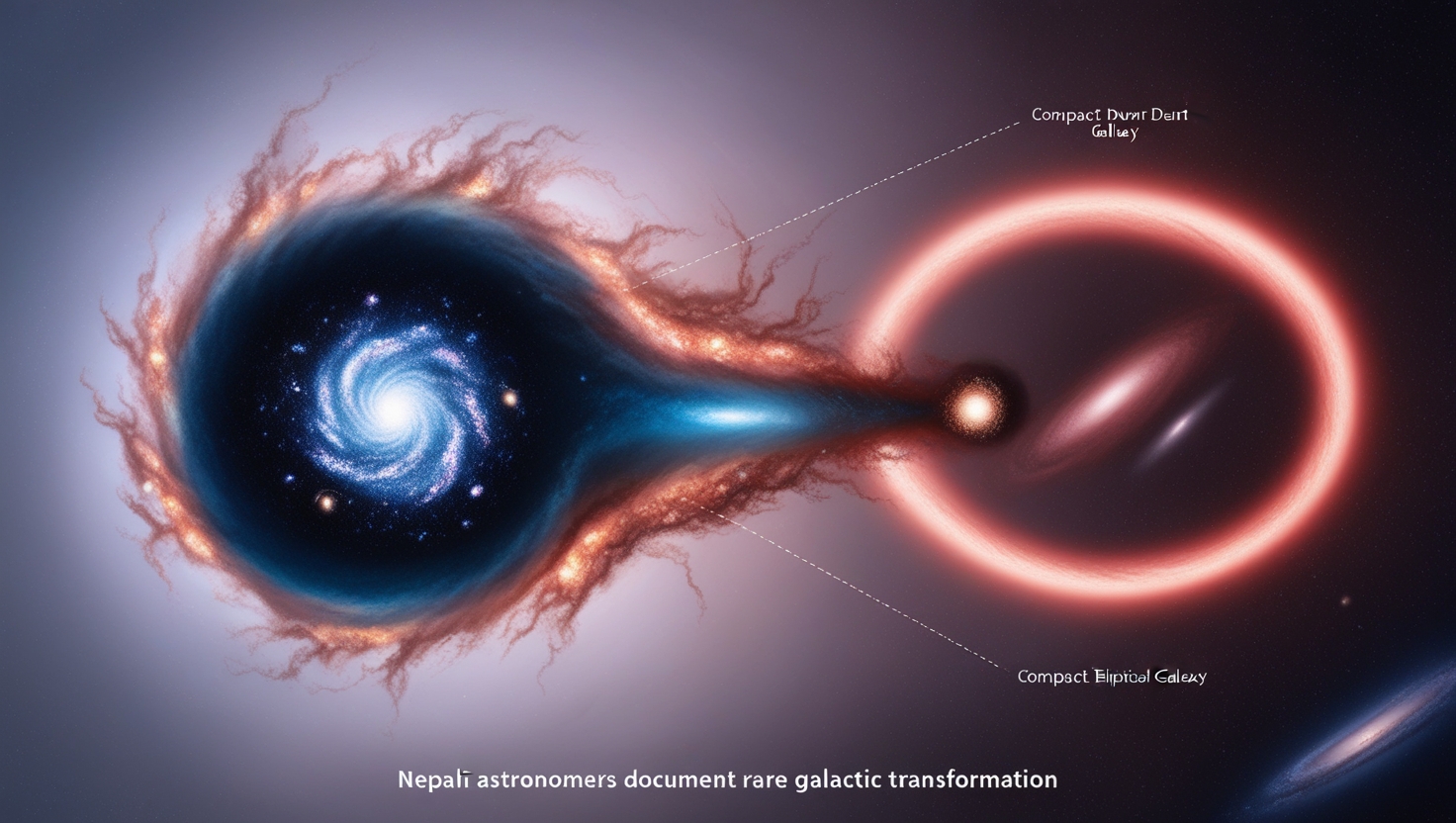Kathmandu – In a landmark achievement for Nepali science, a team of astronomers from Nepal has made a significant breakthrough in understanding galactic evolution. Their pioneering research reveals the rare transformation of a compact dwarf galaxy into an elliptical galaxy—a phenomenon that has remained largely elusive until now.
Led by Dr. Dayanidhi Chhatkuli, an assistant professor at Tribhuvan University, this study was a collaborative effort involving researchers Sanjay Paudel, Binil Aryal, Binod Adhikari, Nauraj Pokhrel, and Rajendra Adhikari. The team’s findings have been published in the prestigious Journal of the Korean Astronomical Society (JKAS) and have attracted global attention from major science platforms such as Phys.org.
A New Window into Galactic Transformation
The focus of the study was a relatively obscure galaxy known as SDSS J134313.15+364457.5, or simply J1343+3644. Through detailed analysis of structural and photometric data, the researchers observed that this compact dwarf galaxy is in the process of evolving into an elliptical galaxy. This discovery provides valuable insights into a critical phase of galactic life cycles that had not been thoroughly explored before.
Dr. Chhatkuli emphasized the novelty of this research: “There has been very limited study on how compact dwarf galaxies transition into elliptical galaxies. Our work fills that gap and marks a significant advance in our comprehension of cosmic evolution.”
Understanding the Cosmic Players: Dwarf and Elliptical Galaxies
Galaxies, vast collections of stars, gas, and dust, come in various shapes and sizes. Dwarf galaxies are the smaller, fainter members of this cosmic family, often overshadowed by their larger counterparts like spiral and elliptical galaxies. Their faintness and small size make them challenging to study, resulting in fewer detailed investigations.
Dwarf galaxies frequently interact gravitationally with larger galaxies. Over thousands of years, these interactions can lead to mergers, where smaller galaxies are absorbed or transformed, contributing to the growth and evolution of larger galaxies. This process is fundamental to understanding how galaxies change over cosmic time.
Dr. Chhatkuli explained, “The merging and transformation of compact dwarf galaxies like J1343+3644 are part of an ongoing cosmic dance. Capturing this galaxy in its transitional phase is a rare and valuable observation.”
What Makes J1343+3644 Special?
One of the standout features of J1343+3644 is its exceptionally high stellar density. The stars are packed tightly together, creating dense clouds of gas that serve as fertile grounds for new star formation. The galaxy contains approximately 7.9 billion solar masses of hydrogen gas, the primary fuel for birthing stars.
Currently, J1343+3644 is forming stars at a rate of about 0.87 solar masses per year. The inner region of the galaxy exhibits a blue hue, signifying active star formation, while the outer shell is red, indicating older stars and little to no new star formation. According to projections, star formation will cease entirely within a few million years, marking the galaxy’s full transition into an elliptical form.
Overcoming Challenges: A Story of Perseverance and Collaboration
Despite the groundbreaking nature of their work, the Nepali research team faced significant obstacles. Notably, they did not receive direct funding from Nepal’s University Grants Commission (UGC), though the institution was formally acknowledged in their publication.
Dr. Chhatkuli shared candidly, “We listed UGC out of formality, but we did not receive any financial support from them. We continue to apply for funding and hope for positive responses in the future.”
The team also faced technological limitations. Nepal currently lacks the advanced telescopes and high-performance computing resources required for such detailed astronomical research. To overcome this, the researchers partnered with South Korean colleagues who provided access to powerful computing facilities necessary for processing and analyzing vast amounts of data.
“We conducted as much of the research as possible from Nepal, but large-scale data analysis required international collaboration,” said Dr. Chhatkuli.
Furthermore, observational data were sourced from global telescopes, as Nepal does not yet have the infrastructure to carry out such high-resolution observations independently. Despite these hurdles, the team’s dedication culminated in a milestone achievement for Nepali astronomy.
Significance and Future Prospects
This discovery is not only a proud moment for Nepal’s scientific community but also a valuable contribution to global astrophysics. Understanding the transformation of dwarf galaxies into elliptical galaxies sheds light on the broader mechanisms governing galaxy formation and evolution over billions of years.
Dr. Chhatkuli remarked, “Studying galaxies like J1343+3644 is akin to reading pages from the universe’s diary. Each galaxy narrates a unique story about the cosmos, and our research reveals a chapter that was previously hidden.”
As Nepal’s space science community continues to grow, this achievement highlights the country’s potential to contribute meaningfully to international scientific endeavors, even with limited resources.
Looking Ahead: Building Capacity and Expanding Horizons
The team hopes their success will inspire increased investment in Nepal’s scientific infrastructure and encourage more young researchers to pursue careers in space science. They advocate for enhanced funding, better equipment, and stronger international partnerships to propel Nepali astronomy to new heights.
In the words of Dr. Chhatkuli, “Our journey shows that with passion, collaboration, and perseverance, even small teams from resource-limited countries can make a global impact. We look forward to many more discoveries that will put Nepal on the map of cutting-edge astronomical research.”
About the Research Paper
-
Published In: Journal of the Korean Astronomical Society (JKAS)
-
Research Team: Dr. Dayanidhi Chhatkuli, Sanjay Paudel, Binil Aryal, Binod Adhikari, Nauraj Pokhrel, Rajendra Adhikari
-
Affiliations: Tribhuvan University, Nepal; Collaborators in South Korea
The discovery of the compact dwarf galaxy J1343+3644’s transition into an elliptical galaxy represents a milestone in both Nepali and global astronomy. It underscores the power of scientific curiosity and international cooperation, demonstrating that groundbreaking research can emerge from unexpected places. As Nepal’s astronomers continue to gaze at the stars, their work promises to illuminate many more cosmic mysteries in the years to come.
Research Paper





















Comments